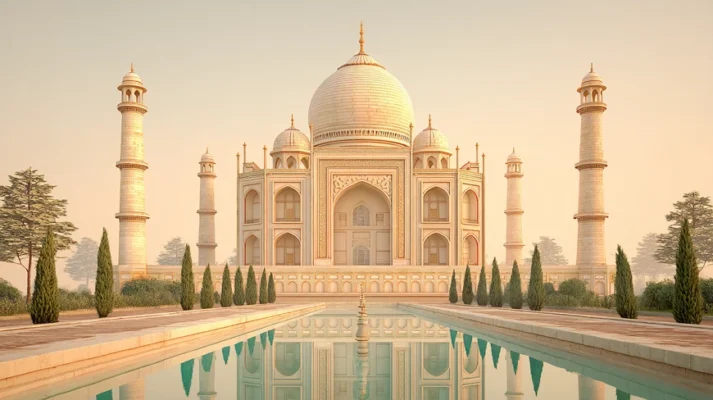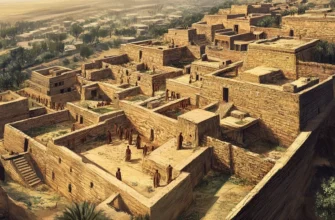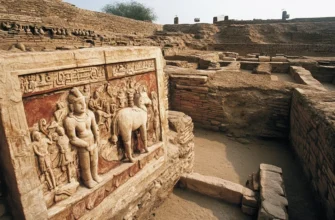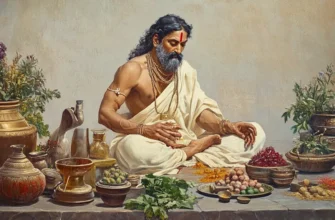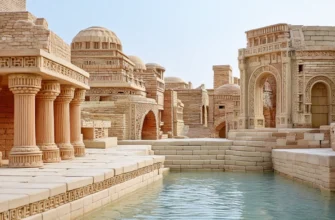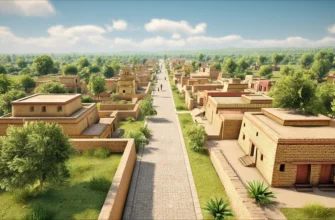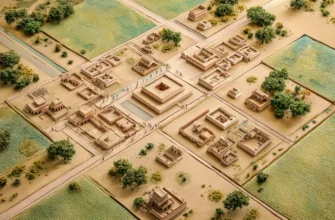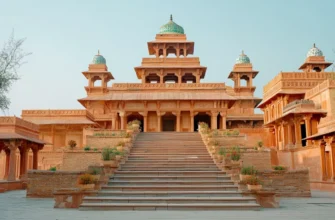The Taj Mahal is one of the most famous architectural monuments in the world, located in Agra, India. This magnificent mausoleum was built by Emperor Shah Jahan in memory of his beloved wife Mumtaz Mahal, who died in childbirth in 1631. Construction of the Taj Mahal began in 1632 and lasted for about 22 years.
The architectural style of the Taj Mahal combines elements of Persian, Indian, and Islamic architecture, making it unique. The main part of the structure is a large white marble building surrounded by symmetrical gardens, pools, and a row of stone buildings. The unique structure and beauty of the Taj Mahal make it a symbol of eternal love and one of the world’s greatest architectural achievements.
The Taj Mahal was added to the UNESCO World Heritage List in 1983 and is an important tourist attraction. It is not only a historical monument but also a true symbol of India’s cultural heritage.
The history of the Taj Mahal
The idea to build the Taj Mahal came to Emperor Shah Jahan after the death of his beloved wife, Mumtaz Mahal. She died in 1631 during childbirth and left a deep mark on the emperor’s heart. Shah Jahan was so devastated by her loss that he decided to build a mausoleum for her that would become a symbol of their eternal love.
Construction of the Taj Mahal began in 1632, and the project was entrusted to the greatest architects of the time. Among them was Ahmad Lahori, who was considered the chief architect of the structure. The Taj Mahal was built on the banks of the Yamuna River, which added even more grandeur and symbolism to the place.
The best materials from all over India and beyond were used to create the mausoleum: white marble was brought from Rajasthan, and precious stones from other countries such as Tibet and Persia. Many masters, artists, and craftsmen worked on the decoration and decorative elements of the structure.
Construction lasted more than 20 years and was completed in 1653. Important elements include the huge dome, tall minarets, and a huge garden with symmetrical alleys. The mausoleum is surrounded by water channels and pools, which add even more grandeur and harmony.
Thus, the Taj Mahal became not only an architectural masterpiece, but also a profound symbol of love and fidelity that has stood the test of time and become one of the most famous monuments in the world.
The love story of Shah Jahan and his wife Mumtaz Mahal
The love story of Shah Jahan and Mumtaz Mahal is one of the most romantic and tragic in the world. Shah Jahan, whose real name was Prince Khuras Khan, was the heir to Emperor Jahangir. Mumtaz Mahal, born Arjumand Banu Begum, was the daughter of a wealthy aristocrat. They met at a young age, and their love blossomed when Shah Jahan fell in love with her at first sight.
Mumtaz Mahal was not only beautiful but also an intelligent woman who held an important place in Shah Jahan’s life. They were inseparable. When Shah Jahan became emperor, he always referred to Mumtaz as his most precious companion. She accompanied him on his travels and actively participated in the management of the empire. During their 19-year marriage, Mumtaz gave the emperor 14 children, and their family seemed happy.
Tragedy struck in 1631 when Mumtaz Mahal died while giving birth to their 14th child in the city of Burhanpur. Shah Jahan was so devastated by her loss that he stopped eating and communicating with other people. He shut himself in his palace and grieved deeply.
This became the catalyst that led to the creation of the Taj Mahal — a symbol of their eternal love. Shah Jahan commissioned the construction of this magnificent mausoleum, which was to be not only a tomb for Mumtaz Mahal, but also an embodiment of his boundless love for her.
He wanted to create an architectural composition that would impress future generations with its beauty and grandeur, leaving a memory of their unbreakable love. The Taj Mahal became a symbol of his tragic loss and, at the same time, the highest expression of devotion.
Construction of the mausoleum
Construction of the Taj Mahal began in 1632, a year after Mumtaz Mahal’s death, when Shah Jahan decided to create a grandiose structure in her honor. It was not just a mausoleum, but an architectural complex that included a garden, a mosque, administrative buildings, and other elements that symbolized beauty and harmony.
Shah Jahan decided to build the Taj Mahal on the banks of the Yamuna River in Agra, in a place that had already become a symbol of his love for Mumtaz Mahal. The first stage of construction included the design and preparation of the site for the foundation.
This took a lot of time and effort, as the structure had to be sturdy enough to support the heavy marble walls and domes. Ahmad Lahori was the architect of the Taj Mahal, and many other masters, craftsmen, and artists from all over India, Central Asia, and Persia worked on this masterpiece.
All materials for construction were selected very carefully. The white marble, which became the main material for the mausoleum, was brought from quarries in Rajasthan, and precious stones for decorative elements were brought from Tibet, Persia, China, and other countries. The best craftsmen were hired to process the marble and other materials, performing intricate carvings and inlays.
The construction of the Taj Mahal lasted about 22 years and was completed in 1653. The main structure is a huge white marble mausoleum with a high dome, which has become a symbol of architectural perfection. An important element is the symmetry of the entire complex, from the central mausoleum to the gardens and water channels.
One of the most impressive aspects of the Taj Mahal is its dome, over 35 meters high, surrounded by four tall minarets. The complex also includes the mausoleums of Emperor Shah Jahan and his wife Mumtaz Mahal, who were buried next to each other.
The Taj Mahal has become not only a symbol of Shah Jahan’s deep love for his wife, but also an architectural masterpiece that impresses with its grandeur and harmony. It is one of the greatest achievements in the history of architecture and culture, which became part of the UNESCO World Heritage Site in 1983.
Architectural features of the Taj Mahal
The Taj Mahal is one of the most famous architectural monuments in the world, and its architecture combines elements of several styles that reflect the cultural heritage of India, Persia, Central Asia, and the Islamic world. Here are some of the main architectural features of the Taj Mahal:
Style and influences
The Taj Mahal is an example of Persian-Islamic style, but with strong Indian and Central Asian influences. This style combines geometric symmetry, tall minarets, huge domes, and detailed decoration, which is characteristic of Islamic architecture of that time. At the same time, it was influenced by Indian style, in particular elements such as exquisite marble carvings and the use of precious stones for inlays.
Materials and construction techniques
The main material used to build the Taj Mahal is white marble brought from quarries in Rajasthan. The marble used in the Taj Mahal has a unique color and shades that change depending on the time of day and weather.
Precious stones, including jade, jasper, lapis lazuli, and various semi-precious stones, were used for decoration and interior design, inlaid into the marble surfaces.
Central dome
One of the most striking architectural features of the Taj Mahal is the large dome that rises above the central part of the mausoleum. The dome, which reaches a height of 35 meters, has a diameter of 17.3 meters, making it one of the largest of its kind. The dome is surrounded by four smaller domes, emphasizing the symmetry of the structure.
Minarets and symmetry
Four huge minarets are located around the main mausoleum, standing at the four corners of the complex building. The minarets serve as both decorative elements and structural supports, further emphasizing the vertical grandeur and scale of the Taj Mahal’s architecture. In addition, the entire building is designed according to the principle of symmetry, which is characteristic of Islamic architecture. The symmetry extends throughout the complex, including the gardens surrounding the mausoleum.
Gardens and water features
The Taj Mahal is surrounded by a huge garden designed according to the Islamic quadrangular garden (jannat) principle. This garden symbolizes paradise on Earth and includes water channels, fountains, and pools that add grandeur and harmony to the entire complex.
The water in the garden also serves to reflect the Taj Mahal, creating an additional atmosphere of peace and solemnity.
Interior decoration
The interior of the Taj Mahal, like its exterior, is impressive in its beauty and detail. Inside the mausoleum are the tombs of Shah Jahan and Mumtaz Mahal. Their tombs are made of marble and decorated with luxurious carved patterns that combine Islamic motifs with Indian traditions. The calligraphy on the walls, which features Arabic inscriptions from the Quran, is particularly striking.
Inlay and carving
A special architectural feature is inlay, the use of precious stones to create intricate patterns on marble surfaces. This art, which was developed during the reign of Shah Jahan, adds extra luxury and sophistication to the Taj Mahal.
Visual effects and atmospheric changes
One of the unique features of the Taj Mahal’s architecture is its ability to change its appearance depending on the time of day and weather. The white marble looks different: in the morning it glows in golden hues, during the day it reflects the blue sky, and in the evening it takes on a soft pink color, emphasizing its elegance and grandeur.
Mosque and other structures
To the west of the main mausoleum is a mosque, which is an important part of the architectural complex. The mosque is made of red sandstone and serves as a place of worship. To the east is another building, which is a symmetrical addition to the mosque and was probably used as a guest hall.
The Taj Mahal impresses not only with its grandeur and beauty, but also with its architectural sophistication, where every element has its own meaning and contributes to the overall harmony and elegance of this unforgettable masterpiece.
The garden and symmetry
One of the most striking features of the Taj Mahal architectural complex is its garden, which is an important element symbolizing not only natural beauty but also the concept of a paradise garden in Islamic culture.
Symmetry as the basis of design
The garden surrounding the Taj Mahal is designed according to the principle of a classic Islamic garden known as “jannat” (paradise). It is divided into four main sections that intersect at the center, creating a clear geometric symmetry.
The principle of symmetry is the basis of the entire design of the Taj Mahal, from the mausoleum itself to the gardens, paths, and water features.
This principle symbolizes the harmony between man, nature, and God. Everything in the garden is organized to be perfect and balanced. The lines of the garden and water channels contribute to the impression of tranquility and spiritual balance.
Garden structure
The garden surrounds the Taj Mahal and is an important part of its overall composition. The garden is square in shape, divided into four equal parts by water channels that intersect in the middle. These channels not only add beauty but also symbolize the rivers of Paradise described in Islamic texts. Each part of the garden has a variety of trees, flowers, and shrubs that add color and life around the mausoleum.
Water features: canals and pools
Water is an important symbol in Islamic architecture, associated with life, purity, and eternity. At the Taj Mahal, the water channels and pools are arranged to reflect the majestic white marble mausoleum. The water adds to the beauty and peaceful atmosphere, and also enhances the effect of symmetry by reflecting the building in its depths.
In addition, the water in the gardens has another practical aspect: it helps to cool the environment during the hot months.
The symbolism of the garden
Islamic gardens are often seen as a symbol of Paradise, where water, plants, and trees represent eternal life, prosperity, and blessings. In the context of the Taj Mahal, this garden has a deep symbolic meaning. It not only serves as a place for walking and contemplation, but also reflects the idea of the connection between the earthly and the heavenly, between life and death, which is emphasized by the idea of eternal love between Shah Jahan and Mumtaz Mahal.
Architectural integration of the garden with the mausoleum
The garden surrounds the Taj Mahal and is an integral part of the architectural complex. The main part of the mausoleum offers a magnificent view of the garden, which contributes to the atmosphere of tranquility and understanding of grandeur. The entire composition is designed in such a way that each element emphasizes the other: the symmetry of the garden enhances the grandeur of the Taj Mahal, and its beauty, in turn, adds emotional power and impression to this unique place.
Thus, the garden and symmetry of the Taj Mahal not only serve an aesthetic function but also have a deep symbolic meaning. They become part of the overall idea of the Taj Mahal as a symbol of boundless love, harmony, and spiritual beauty.
The Taj Mahal in culture and art
The Taj Mahal is not only an architectural monument but also a symbol of Indian culture, art, and history. Its beauty and grandeur impress not only people who visit this place but also artists, writers, musicians, and cultural figures around the world. Over time, the Taj Mahal has become an important symbol of Indian and world culture.
Symbol of eternal love
The Taj Mahal gained popularity as a symbol of eternal love between Shah Jahan and his wife Mumtaz Mahal. This concept has become the basis for numerous cultural and artistic works. In literature, the Taj Mahal often serves as a metaphor for unbreakable devotion, reflecting the depth of emotions and feelings. The story of its creation, which is both a story of tragic loss and deep love, has inspired poets and authors to create numerous poems, novels, and short stories.
The Taj Mahal in painting and photography
The Taj Mahal has become a popular subject for artists and photographers. Its image has been used as a symbol of beauty, purity, and elegance in various artistic styles. During the era of British colonialism in the 19th century, many artists from Western Europe depicted the Taj Mahal in their paintings, emphasizing its grandeur and exoticism. There are numerous watercolors, paintings, and drawings that convey the grandeur of the Taj Mahal in different lighting conditions and seasons.
In recent decades, the Taj Mahal has become the subject of countless photographs, often depicting it against the backdrop of sunrise or sunset. Today’s photography techniques allow photographers to capture moments when changing light creates incredible visual effects, emphasizing the grandeur and beauty of the mausoleum.
The Taj Mahal in film and music
The Taj Mahal also appears frequently in cinema. Its image in film is often associated with the symbol of the enduring idea of love, even in the most difficult circumstances. In many Indian films, the Taj Mahal is portrayed as a place of passionate love that has survived time and death.
Musicians also turn to the Taj Mahal as a source of inspiration. In musical compositions, especially in Indian melodies, the Taj Mahal appears as a symbol of spiritual superiority, beauty, and harmony. Its name has been mentioned in countless songs, poems, and compositions that emphasize the emotional connection between place and love.
The Taj Mahal in popular culture
In popular culture, the Taj Mahal often appears as a symbol of India, its history, and cultural heritage. Thanks to its incredible beauty, it has become part of the world’s cultural identity, often associated with the idea of Indian romance and exoticism. Millions of tourists visit India every year to see this architectural masterpiece, which has made the Taj Mahal a symbol of Indian hospitality and cultural significance.
The Taj Mahal as a tourist attraction
Due to its significance, the Taj Mahal has also become an important part of the tourism industry. Millions of tourists from all over the world come to see this masterpiece and experience its mystical and historical depth. The Taj Mahal has become a place of pilgrimage for those seeking visual and emotional harmony. The grandeur of the mausoleum embodies India’s great heritage and draws attention to the country’s cultural wealth.
The Taj Mahal in architecture
The architectural grandeur of the Taj Mahal has been the inspiration for numerous Western and Eastern architectural masterpieces. Its stylistic elements and technical achievements, including the use of marble, symbolic motifs, and huge domes, have inspired numerous building projects around the world.
The Taj Mahal has set the highest standards of quality and aesthetics for many generations of architects.
Influence on contemporary design
Contemporary design often uses elements of the Taj Mahal, from marble patterns to the use of domes and minarets.
Architects around the world, from Mumbai to New York, draw inspiration from this masterpiece when designing modern cultural venues, hotels, parks, and museums.
The Taj Mahal in literature and poetry
Over time, the Taj Mahal has become part of world literature and poetry, where its image symbolizes love, tragedy, and memory. Countless poets, from the Romantic period to contemporary authors, refer to this majestic mausoleum as the ideal image of love and fidelity that survives death.
The Taj Mahal has become more than just an architectural masterpiece — it has permeated various spheres of culture and art, becoming one of the most recognized and revered symbols not only of India but of human civilization as a whole. Its influence on culture, art, and literature is enormous, and it continues to inspire generations of artists, writers, and admirers of beauty around the world.
Preserving the heritage
As one of the world’s most famous architectural landmarks, the Taj Mahal is not only a national treasure of India but also an important part of the world’s cultural heritage. Its historical and cultural significance, along with its unique architectural beauty, attract millions of tourists every year. However, the preservation of the Taj Mahal faces several serious challenges that threaten its integrity and longevity. Here are some of them:
Environmental pollution
One of the main threats to the Taj Mahal is air pollution, especially from industrial activity in the vicinity of Agra, where the mausoleum is located. Emissions from cars, industrial plants, and factories cause soot and other pollutants to accumulate on the surface of the marble. This can lead to the darkening of the white marble and the loss of its aesthetic appeal. To combat this problem, restrictions have been imposed on industrial development in the vicinity of the Taj Mahal, and methods for cleaning and restoring the marble are being actively implemented.
Tourism and excessive load
The Taj Mahal is one of the most visited monuments in the world, attracting over 7 million tourists a year. The large number of visitors undoubtedly poses a risk to the preservation of this site. High levels of human activity can damage architectural elements and interiors, as well as cause physical wear and tear to the main structures. To reduce this impact, visitor numbers have been limited, special visiting hours have been established, and strict rules have been introduced to maintain cleanliness and order in the area.
Seismic activity and natural disasters
India, where the Taj Mahal is located, is in a seismically active zone, and earthquakes can pose a serious threat to the integrity of the building. The Taj Mahal was built more than 350 years ago, and its design did not include modern earthquake-resistant measures.
Regular research and restoration work is carried out to strengthen the building and ensure its resistance to possible natural disasters.
Restoration and restoration of marble
The Taj Mahal is made of high-quality white marble, which is very vulnerable to atmospheric influences and pollution. Over time, the surface of the marble can lose its purity and shine. Restoration work requires not only considerable effort but also special techniques and materials to preserve the originality of the monument. Incorrect restoration methods can damage the building, so it is important that the work is carried out by qualified specialists, taking into account the historical and architectural features of the Taj Mahal.
Secrets of preservation and management of the monument
In order to protect the Taj Mahal from various threats, the Indian government has introduced several initiatives. The Taj Mahal is part of a broader cultural heritage protection program that restricts construction in the surrounding areas and regulates the number of tourists visiting the monument. In addition, measures are being taken to protect against vandalism, and special security zones have been created where access to the site is strictly controlled.
One important initiative is the creation of national parks and nature reserves in the immediate vicinity of the Taj Mahal, which not only preserves the architectural monument but also maintains the natural balance in the region.
Cooperation with international organizations
The Taj Mahal was added to the UNESCO World Heritage List in 1983, which helped attract international assistance for its protection.
Cooperation with organizations such as UNESCO, the International Center for the Preservation of Cultural Heritage, and other institutions promotes the development of conservation technologies and methods and provides financial support for restoration work.
Strategies for future preservation
To preserve the Taj Mahal in the future, it is necessary to implement the latest monitoring technologies, study changes in the atmosphere, and use environmentally friendly methods to clean the building. Equally important is improving tourist flow management and raising public awareness of the importance of preserving cultural heritage. All these measures will help ensure that the Taj Mahal is preserved for future generations.
The Taj Mahal is a priceless treasure of world architecture, and its preservation requires constant attention and effort on the part of the Indian government and the international community. The problems facing the monument require a comprehensive approach that includes not only restoration work but also the implementation of sustainable and environmentally friendly practices to protect this unique heritage site from natural and human threats.
Conclusion
The Taj Mahal is not only one of India’s greatest architectural monuments, but also a symbol of deep emotion and cultural grandeur that reflects history, art, and spirituality.
For India, this mausoleum is not just an architectural monument, but a national symbol that highlights the richness of the cultural heritage and the craftsmanship of Indian builders and artists. The Taj Mahal embodies the ideas of love, self-sacrifice, and eternity, which are deeply engraved in the Indian cultural context.
On a global level, the Taj Mahal is an expression of universal values such as beauty, symmetry, harmony, and creativity. Its architecture has been a source of inspiration for many generations of architects and artists and has influenced the development of building traditions in various parts of the world. Together with other world heritage sites, the Taj Mahal embodies the importance of preserving cultural and historical heritage for future generations.
The Taj Mahal is also a place that brings together people from different cultures and countries, attracting millions of tourists every year. It is recognized as a symbol of love and fidelity, making it an important cultural element that transcends national borders and carries a message of peace and unity. The Taj Mahal is a monument that transcends time, connects the past and the present, and continues to impress with its grandeur and beauty, remaining an important symbol of world cultural heritage.
